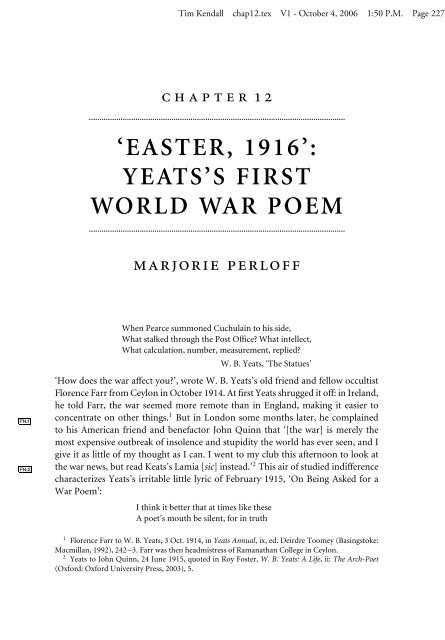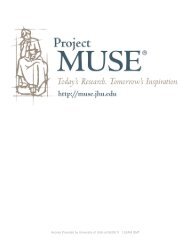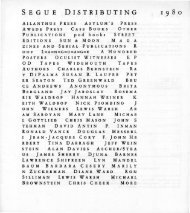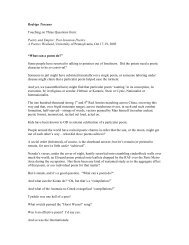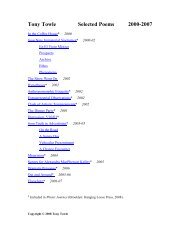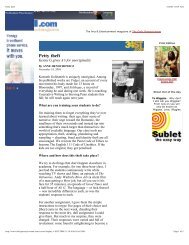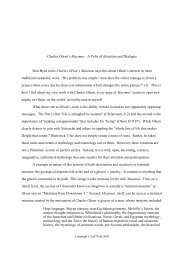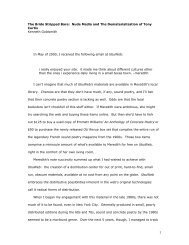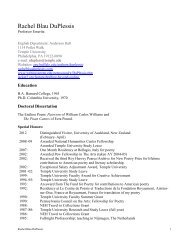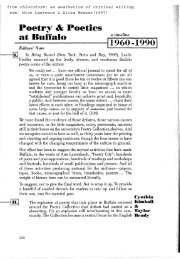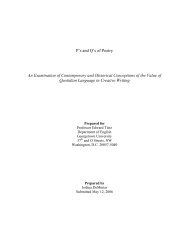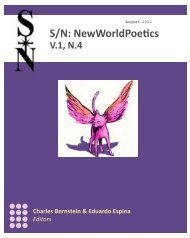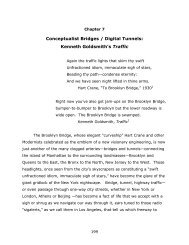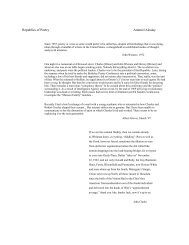'EASTER, 1916': YEATS'S FIRST WORLD WAR POEM
'EASTER, 1916': YEATS'S FIRST WORLD WAR POEM
'EASTER, 1916': YEATS'S FIRST WORLD WAR POEM
You also want an ePaper? Increase the reach of your titles
YUMPU automatically turns print PDFs into web optimized ePapers that Google loves.
FN:1<br />
FN:2<br />
Tim Kendall chap12.tex V1 - October 4, 2006 1:50 P.M. Page 227<br />
c h a p t e r 1 2<br />
• • • • • • • • • • • • • • • • • • • • • • • • • • • • • • • • • • • • • • • • • • • • • • • • • • • • • • • • • • • • • • • • • • • • • • • • • • • • • • • • • • • • • • • • • • • • • • • • • • • • • • • • • • • • • • • • • • • • • • • • •<br />
‘EASTER, 1916’:<br />
YEATS’S <strong>FIRST</strong><br />
<strong>WORLD</strong> <strong>WAR</strong> <strong>POEM</strong><br />
• • • • • • • • • • • • • • • • • • • • • • • • • • • • • • • • • • • • • • • • • • • • • • • • • • • • • • • • • • • • • • • • • • • • • • • • • • • • • • • • • • • • • • • • • • • • • • • • • • • • • • • • • • • • • • • • • • • • • • • • •<br />
marjorie perloff<br />
When Pearce summoned Cuchulain to his side,<br />
What stalked through the Post Office? What intellect,<br />
What calculation, number, measurement, replied?<br />
W. B. Yeats, ‘The Statues’<br />
‘How does the war affect you?’, wrote W. B. Yeats’s old friend and fellow occultist<br />
Florence Farr from Ceylon in October 1914. At first Yeats shrugged it off: in Ireland,<br />
he told Farr, the war seemed more remote than in England, making it easier to<br />
concentrate on other things. 1 But in London some months later, he complained<br />
to his American friend and benefactor John Quinn that ‘[the war] is merely the<br />
most expensive outbreak of insolence and stupidity the world has ever seen, and I<br />
give it as little of my thought as I can. I went to my club this afternoon to look at<br />
the war news, but read Keats’s Lamia [sic] instead.’ 2 This air of studied indifference<br />
characterizes Yeats’s irritable little lyric of February 1915, ‘On Being Asked for a<br />
War Poem’:<br />
I think it better that at times like these<br />
A poet’s mouth be silent, for in truth<br />
1 Florence Farr to W. B. Yeats, 3 Oct. 1914, in Yeats Annual, ix, ed. Deirdre Toomey (Basingstoke:<br />
Macmillan, 1992), 242–3. Farr was then headmistress of Ramanathan College in Ceylon.<br />
2 Yeats to John Quinn, 24 June 1915, quoted in Roy Foster, W. B. Yeats: A Life, ii: The Arch-Poet<br />
(Oxford: Oxford University Press, 2003), 5.
FN:4<br />
FN:5<br />
FN:6<br />
228 marjorie perloff<br />
FN:3<br />
Tim Kendall chap12.tex V1 - October 4, 2006 1:50 P.M. Page 228<br />
We have no gift to set a statesman right;<br />
He’s had enough of meddling who can please<br />
A young girl in the indolence of her youth,<br />
Or an old man upon a winter’s night. 3<br />
The request had come from Henry James, who was helping Edith Wharton bring<br />
out a collection of war poems to raise money for the Belgian refugees in Paris. 4 The<br />
poem, first called ‘To a friend who has asked me to sign his manifesto to the neutral<br />
nations’ and then ‘A Reason for Keeping Silent’, inspired an angry response from<br />
the strongly anti-German Quinn, who told Yeats, ‘those five or six lines were quite<br />
unworthy of you and the occasion . . . . I do not believe in divorce between letters<br />
and life or art and war.’ 5<br />
The divorce persisted, however, during the winters with Ezra Pound at Stone<br />
Cottage, where in 1914–15 Yeats studied and adapted the stylized rituals of the Noh<br />
drama and completed the first volume of his autobiography, Reveries over Childhood<br />
and Youth. Pound, as James Longenbach notes, was becoming increasingly caught<br />
up in the war fever, especially after the death at the Front of his great artist friend<br />
Henri Gaudier-Brzeska in June 1915. But Yeats remained aloof: his own Noh play,<br />
At the Hawk’s Well, designed by Edmund Dulac and danced by Michio Ito, a disciple<br />
of Nijinsky from the Ballet Russe, had its first performance (4 April 1916) at Lady<br />
Cunard’s at what turned out to be, ironically enough, a war charity affair. 6 Having<br />
launched At the Hawk’s Well, Yeats set off for Sir William Rothenstein’s idyllic<br />
cottage in the Cotswolds to spend the Easter holiday. Sir William had planned to<br />
paint Yeats’s portrait.<br />
It was here on Easter Monday (24 April) that Yeats received word of the Rising.<br />
The rebellion moved him as no account of the Battle of the Somme or Verdun ever<br />
could, for the principals were mostly people he knew personally, and his own future<br />
hung in the balance. The Rising was the first decisive event to threaten Yeats’s ability<br />
to advance the Irish cause from his base in London, where he had lived a large<br />
part of his life, ever since his schooldays. It was in London, after all, that Yeats’s<br />
early writings were published, in London that he founded the Irish Literary Society<br />
(1891), the Gaelic League (1893), and so on. Even if he complained of being a<br />
stranger in London, Yeats held the privileged position of the Protestant Anglo-Irish<br />
Ascendancy. ‘The loose federation of personalities Yeats gathered around himself’,<br />
Declan Kiberd notes, ‘was one of the very first groups of decolonizing intellectuals<br />
to formulate a vision of their native country during a youthful sojourn in an<br />
3 Yeats, ‘On Being Asked for a War Poem’, in The Poems, ed. Daniel Albright (London: Dent,<br />
1990), 205.<br />
4 See James Longenbach, Stone Cottage: Pound, Yeats and Modernism (Oxford: Oxford University<br />
Press, 1988), 118.<br />
5 John Quinn, quoted in Albright, ‘Notes to Poems’, in Yeats, Poems, 579.<br />
6 See Foster, W. B. Yeats, ii. 40.
FN:7<br />
FN:8<br />
FN:9<br />
FN:10<br />
FN:11<br />
Tim Kendall chap12.tex V1 - October 4, 2006 1:50 P.M. Page 229<br />
‘easter, 1916’ 229<br />
imperial capital.’ 7 From his perch in London, Yeats could do many things to further<br />
the Irish cause, the downside being that the poet’s Ireland, at this stage, was largely<br />
invention, an imaginary homeland, characterized, in Kiberd’s words, by its mix ‘of<br />
Celticism and Peter Pannery’. 8 Indeed, the poet’s real literary roots were planted<br />
firmly in the English Romantic tradition, especially that of Blake and Shelley.<br />
Ironically for Yeats, it was the British engagement in the Great War, an engagement<br />
he had derided as a great nuisance and distraction, that brought about<br />
the Easter Rising. The Irish Home Rule Bill, first introduced into Parliament by<br />
Gladstone in 1893 and passed by the House of Commons in 1912, requiring only<br />
the expected endorsement of the Lords to become law, was summarily tabled in<br />
Parliament. The new leader of the Irish Party, John Redmond, accepted this state<br />
of affairs. Indeed, Home Rule, in Kiberd’s words, ‘was to be the post-war reward<br />
for Redmond’s support for England and for ‘‘plucky Catholic Belgium’’. Tens of<br />
thousands of Irishmen volunteered to fight (as they saw it) for the rights of small<br />
nations; other members of the Irish Volunteers felt in all conscience that this was<br />
not their war.’ 9 These latter now flocked to the IRB (Irish Republican Brotherhood)<br />
as well as to Arthur Griffith’s Sinn Féin (‘ourselves alone’) movement.<br />
The scene was thus set for the Easter Rising, but neither Yeats nor Lady Gregory<br />
and her circle expected it; indeed, they reacted with shock to the news that on Easter<br />
Monday some 700 members of the IRB, led by Patrick Pearse, had occupied first the<br />
Post Office and from there the centre of Dublin, and proclaimed the founding of an<br />
independent Irish State. The Rising lasted less than a week: Pearse, appalled by the<br />
slaughter of civilians, surrendered on the Saturday after Easter; by then, more than<br />
300 citizens had been killed, as well as more than 130 British soldiers and 70 rebels.<br />
British retaliation was severe. Between 3 and 12 May, fifteen rebel leaders were<br />
executed, ‘despite’, as Kiberd tells us, ‘a strong consensus that they should have<br />
been treated as prisoners-of-war. Martial law was imposed and 3,500 people were<br />
arrested, more than twice the number which had actually taken part in the Rising.’ 10<br />
Yeats’s reaction can be traced in his correspondence with Lady Gregory, his sisters,<br />
and various friends. Despite initial suspicion of the rebels, Yeats sympathized with<br />
most of the principals: Thomas MacDonagh, a university lecturer and literary critic,<br />
had dedicated a book to him; Joseph Plunkett came from an affluent, cultured<br />
Dublin family; James Connolly was an actor at the Abbey Theatre; Constance<br />
Markiewicz had been born a Gore-Booth; she and her sister Eva represented, for<br />
Yeats, the country house gentry near Sligo. Most important: John MacBride was<br />
Maud Gonne’s estranged husband. At the same time, Yeats disliked Pearse—‘a<br />
man made dangerous by the Vertigo of Self Sacrifice’ 11 —and had contempt for<br />
7 Declan Kiberd, Inventing Ireland: The Literature of the Modern Nation (Cambridge, Mass.:<br />
Harvard University Press, 1995), 100.<br />
8 Ibid. 113. 9 Ibid. 192–3. 10 Ibid. 193.<br />
11 Yeats to Lolly Yeats, n.d., quoted in Foster, W. B. Yeats, ii. 46; see also Longenbach, Stone Cottage,<br />
56.
FN:12<br />
FN:13<br />
230 marjorie perloff<br />
Tim Kendall chap12.tex V1 - October 4, 2006 1:50 P.M. Page 230<br />
Arthur Griffith, the leader of Sinn Féin. Accordingly, his initial stance was one of<br />
caution: ‘There is nothing to be done but to do one’s work and write letters.’ 12 And<br />
he remained in his London flat, detached from the turmoil.<br />
But by May, reports came in of the murder, by the British police, of the<br />
pacifist Francis Sheehy Skeffington, a popular Dublin figure, well known to Yeats.<br />
Furthermore, the wholesale execution of the rebels aroused the sympathy of Lady<br />
Gregory as well as the entire Yeats family. Those hitherto regarded with bemusement<br />
and some contempt joined the visionary company of the great nineteenth-century<br />
Irish patriots Robert Emmet and Wolfe Tone. Yeats now became sharply critical of<br />
the English government. In an important letter to Lady Gregory, he wrote:<br />
If the English conservative party had made a declaration that they did not intend to rescind<br />
the Home Rule Bill there would have been no rebellion. I had no idea that any public event<br />
could so deeply move me—and I am very despondent about the future. At this moment I<br />
feel that all the work of years has been overturned, all the bringing together of classes, all<br />
the freeing of Irish literature & criticism from politics . . . . I do not yet know what [Maud<br />
Gonne] feels about her husband’s death. Her letter was written before she heard of it. Her<br />
main thought seems to be ‘tragic dignity has returned to Ireland’. She had been told by two<br />
members of he Irish Party that ‘Home Rule was betrayed’. She thinks now that the sacrifice<br />
has made it safe. 13<br />
And he adds, ‘I am trying to write a poem on the men executed—‘‘terrible beauty<br />
has been born’’.’<br />
It is interesting to observe how contradictory even this letter is. When Yeats<br />
notes that ‘all the work of years has been overturned’, he is not referring to the<br />
drive for Irish freedom but, on the contrary, to his old Gaelic League effort to<br />
‘free’ Irish literature from all politics—an effort already made futile by the events<br />
themselves. As for the ‘bringing together of classes’, one senses that Yeats is more<br />
eager to find himself at one with the class above him, the aristocracy, than to<br />
befriend the members of the working class. And as for Maud Gonne’s aphorism<br />
on tragic dignity, it is not at all clear that Yeats agrees with it. But he could not<br />
bring himself to cross her. Indeed, after a brief visit to Dublin in early June, Yeats<br />
decided to spend the summer in Normandy, where Maud Gonne was living with<br />
her children, with the stated intention of proposing marriage to her once again.<br />
When Gonne—predictably—refused, he turned to her daughter Iseult, proposing<br />
to her as well, and again being refused. The neurotic relationship with both women<br />
dragged on until, at the end of August, Lady Gregory summoned Yeats back to<br />
Ireland and took him straight to Coole Park for a much-needed rest. It was at Coole<br />
on 25 September that Yeats finished ‘Easter, 1916’.<br />
I detail this material, much of it familiar to Yeats students, so as to help the<br />
reader understand that a political poem like ‘Easter, 1916’—or, for that matter,<br />
12 Yeats to Lolly Yeats, n.d., quoted in Foster, W. B. Yeats, ii. 46.<br />
13 Yeats to Lady Gregory, 11 May 1916, in The Letters of W. B. Yeats, ed. Allen Wade (London:<br />
Rupert Hart-Davis, 1954), 612–13; my italics.
FN:14<br />
FN:15<br />
Tim Kendall chap12.tex V1 - October 4, 2006 1:50 P.M. Page 231<br />
‘easter, 1916’ 231<br />
Yeats’s later ‘Nineteen Hundred and Nineteen’ and ‘Meditations in Time of Civil<br />
War’—responds to particular situations in all their ambiguity. Today, when ‘antiwar<br />
poems’ are usually written by those whose knowledge of the war in question<br />
is largely derived from the media and whose positions are usually both simple and<br />
clear-cut (for example, ‘The Iraq war was motivated by the lust for Middle Eastern<br />
oil’), the political complexity of modernist war poetry must come as a great surprise.<br />
It is the common wisdom that modernism was ‘aestheticist’, that its autonomous<br />
art was far removed from ‘life’, and that this ‘great divide’, as Andreas Huyssen<br />
called it in his book of that title, must be broached by a rapprochement between<br />
‘high’ and ‘low’ art, between art and popular culture. But the more one studies<br />
the great modernist poets and fiction writers, the more dubious this postmodernist<br />
proposition seems. Indeed, Yeats’s writing demonstrates—as does that of Eliot<br />
and Pound—how readily so-called ideological positions are contaminated by<br />
extraneous factors, in Yeats’s own case, by his lifelong passion for Maud Gonne,<br />
herself a fiery revolutionary, so devoted to the Irish Nationalist cause that, in later<br />
life, she condoned Hitler’s actions, declaring that at least the Germans hated the<br />
English as much as she did. Gonne was also virulently anti-Semitic. 14<br />
Yeats, in any event, tried to write a poem on the Rising that Gonne might admire<br />
even as it would also satisfy the Dublin public and convey his own ambivalence<br />
toward the events of 1916. As a poet, moreover, whose readership in England and<br />
the United States was at least as large as that in his native Ireland, Yeats faced the<br />
difficult challenge of presenting as tragedy an event that, given the larger war picture<br />
of 1916, was hardly considered to have major import. On 1 July, after all, the Battle<br />
of the Somme began, a battle best remembered for its first day, on which the British<br />
suffered 60,000 casualties (20,000 deaths). It was the bloodiest day in the history of<br />
the British Army, and the battle, dragging on till November, produced over 460,000<br />
casualties altogether. How to process the horror of such a set of circumstances?<br />
‘Things fall apart; the centre cannot hold,’ 15 as ‘The Second Coming’ has it, but<br />
how and why?<br />
Yeats was a great mythographer. The Sligo countryside, as literary tourists know,<br />
is hardly beautiful or even especially distinctive, but Yeats manages, throughout his<br />
poetry, to transform it into one of poetry’s Sacred Places even as he makes readers<br />
long to see Lissadell (the home of the Gore-Booth sisters), Ben Bulben, and Coole<br />
Park. In ‘Easter, 1916’, the trick is to immortalize the rebels, not as heroes in the<br />
abstract, but as agents of change—change by no means all positive, but dramatic in<br />
the mere fact of its taking place. And drama is the key word here, for Yeats presented<br />
14 See Foster, W. B. Yeats, ii. 344–5, 468–9. ‘Gonne, years after the post-war revelations of genocide,<br />
was still saying that if she had been German, the only thing that would have stopped her becoming<br />
a Nazi was their exclusion of women from positions of power; she also boasted of telling Richard<br />
Ellmann (‘‘a young American Jew’’) that, compared to Hiroshima and Nagasaki, Hitler’s death-camps<br />
were ‘‘quite small affairs’’ .’<br />
15 Yeats, ‘The Second Coming’, in Poems, 235.
FN:16<br />
232 marjorie perloff<br />
Tim Kendall chap12.tex V1 - October 4, 2006 1:50 P.M. Page 232<br />
his characters as actors playing out a script largely beyond their control, actors<br />
caught up in a street theatre in which their individual identities are subordinated<br />
to a larger communal drive, Easter itself symbolizing the power and possibility of<br />
wholesale renewal.<br />
Numerology plays an important part in the poem. ‘Easter, 1916’ has four stanzas<br />
of 16, 24, 16, 24 lines respectively, covertly embodying the Rising’s date—the<br />
twenty-fourth day of the fourth month of the year 1916—even as its metre offsets<br />
these multiples of four with a trimeter or, more properly, a three-stress line, the<br />
number of syllables varying between six and nine. 16 Yeats makes his trimeter<br />
dramatic by introducing regular trochaic substitutions, as in<br />
Coming with vivid faces<br />
as well as overstressing his lines and introducing caesurae—<br />
All changed, || changed utterly<br />
—where only one of the six syllables receives no stress, creating the effect of an<br />
insistent drumbeat. The use of fricatives and voiced and voiceless stops in the<br />
refrain makes these heavily stressed syllables even more emphatic:<br />
All changed, changed utterly:<br />
A terrible beauty is born.<br />
And the rhyme, ababcdcd, reinforces the four-part structure of the poem, its sense<br />
of eternal recurrence in the midst of seeming change.<br />
Within this elaborate formal structure, the colloquial dominates, at least in the<br />
poem’s opening, which begins, not with an account of the Rising itself—indeed,<br />
that tale is never told—but with the word ‘I’, placing the poet, and his attempt at<br />
understanding what has happened, at centre-stage:<br />
I have met them at close of day<br />
Coming with vivid faces<br />
From counter or desk among grey<br />
Eighteenth-century houses.<br />
I have passed with a nod of the head<br />
Or polite meaningless words,<br />
Or have lingered awhile and said<br />
Polite meaningless words,<br />
And thought befoe I had done<br />
Of a mocking tale or a gibe<br />
16 This structure was first noticed by one of Helen Vendler’s students, Nathan Rose. See Vendler,<br />
‘Technique in the Earlier Poems of Yeats’, in Yeats Annual, viii, ed. Warwick Gould (Basingstoke:<br />
Macmillan, 1991), 20 n. 4; cf. Terence Brown, The Life of W. B. Yeats (Oxford: Blackwell, 1999), 233–4.<br />
I have discussed the verse form and structure vis-à-vis Matthew Arnold’s ‘Haworth Churchyard’, in<br />
‘Yeats and the Occasional Poem: ‘‘Easter 1916’’ ’, Papers on Language & Literature, 4/3 (Summer 1968),<br />
308–28.
FN:18<br />
FN:17<br />
Tim Kendall chap12.tex V1 - October 4, 2006 1:50 P.M. Page 233<br />
To please a companion<br />
Around the fire at the club<br />
Being certain that they and I<br />
But lived where motley is worn:<br />
All changed, changed utterly:<br />
A terrible beauty is born. 17<br />
‘easter, 1916’ 233<br />
‘The power of [Yeats’s] poem’, writes Declan Kiberd, ‘derives from the honesty with<br />
which he debates the issue, in the process postponing until the very last moment his<br />
dutiful naming of the dead warriors: this had been, of course, the practice of bards<br />
after a battle, in which they invariably claimed that the land had been redeemed<br />
by the sacrifice. Yeats’s entire lyric is a sequence of strategies for delaying such<br />
naming.’ 18 The delay of naming—the almost contemptuous use of ‘them’ in the<br />
opening lines—has another effect: it brings the reader squarely into the poet’s radius<br />
of discourse, as if to say, ‘You know who these guys are, better than I do’. Their ‘vivid<br />
faces’ stand out against the backdrop of the twilight, like actors on a darkened stage.<br />
In line 3, Yeats designates their status with the economical synecdoche of ‘counter<br />
or desk’—shop or office. And those shops and offices—ordinary workplaces—are<br />
what the elegant ‘Eighteenth-century houses’ of Dublin have come to house.<br />
Ordinary people coming home from ordinary jobs: the poet recalls exchanging no<br />
more than ‘polite meaningless words’ with these Dubliners, later making fun of<br />
their remarks to his friends at the club, ‘Being certain that they and I / But lived<br />
where motley is worn’—motley, the fool’s variegated garment.<br />
In his 1915 letter to Quinn cited above, Yeats talks of retreating to his London<br />
club and reading Keats’s Lamia rather than listening to the war news. The<br />
English–German War, he repeatedly insisted, was not his concern. But ironically,<br />
in inuring himself from the Great War, Yeats had also remained aloof from the<br />
recent Irish troubles: at Stone Cottage, the Pound–Yeats curriculum was heavily<br />
weighed to such exotic arts as the Noh theatre, the irony being that war looms<br />
large in precisely these Japanese plays. ‘All changed, changed utterly’: however<br />
the Rising was to be judged, its sudden intrusion into the daily round of Dublin<br />
life, captured by the ‘round’ of the rhyming trimeter stanza, marks a momentous<br />
change—a cataclysm oddly mirroring what was happening on the Western Front,<br />
unanticipated as the deadly trench warfare of 1916 had been in the idyllic summer<br />
when war broke out.<br />
In the second stanza, Yeats dramatizes the complex meaning of the Rising in a<br />
roll-call of four of its yet unnamed ‘heroes’:<br />
That woman’s days were spent<br />
In ignorant good-will,<br />
Her nights in argument<br />
Until her voice grew shrill.<br />
17 Yeats, ‘Easter, 1916’, in Poems, 228–30. 18 Kiberd, Inventing Ireland, 213.
FN:19<br />
FN:20<br />
234 marjorie perloff<br />
Tim Kendall chap12.tex V1 - October 4, 2006 1:50 P.M. Page 234<br />
What voice more sweet than hers<br />
When, young and beautiful,<br />
She rode to harriers?<br />
This man had kept a school<br />
And rode our winged horse;<br />
This other his helper and friend<br />
Was coming into his force;<br />
He might have won fame in the end,<br />
So sensitive his nature seemed,<br />
So daring and sweet his thought.<br />
This other man I had dreamed<br />
A drunken, vainglorious lout.<br />
He had done most bitter wrong<br />
To some who are near by heart,<br />
Yet I number him in the song;<br />
He too has resigned his part<br />
In the casual comedy;<br />
He, too, has been changed in his turn,<br />
Transformed utterly:<br />
A terrible beauty is born.<br />
Yeats’s roll-call is carefully calculated. Of the seven men who actually signed<br />
the Proclamation of the Republic—Padraic Pearse, Thomas MacDonagh, James<br />
Connolly, Eamon Ceannt, Joseph Mary Plunkett, Sean MacDermott, and Thomas<br />
Clarke—only the first two figure here. Pearse, however fanatical Yeats took him to<br />
be, was something of a poet, and his transformation from sideline spoiler to leader<br />
of the rebellion certainly merited attention. MacDonagh was more sympathetic: the<br />
poem pays tribute to his literary gift and his sensitivity, although Yeats had earlier<br />
suggested that Ireland gave MacDonagh no breathing room, that he should have<br />
moved to England in order to realize his potential. 19<br />
But it is the first and fourth actors who get the most attention: Constance<br />
Markiewicz, née Gore-Booth, once a beautiful, aristocratic young horsewoman,<br />
whose grace and charm, so the poet posits, have been destroyed by revolutionary<br />
zeal, is, as Elizabeth Cullingford has noted, a stand-in for Maud Gonne, whom<br />
Yeats regularly castigated for her ‘shrill’ and all-consuming political activism. 20<br />
Gonne, living in France, could not be listed since she played no actual role in the<br />
19 In his 1909 diary ‘Estrangement’, Yeats writes, ‘Met MacDonagh yesterday—a man with some<br />
literary faculty which will probably come to nothing through lack of culture and encouragement . . . .<br />
In England this man would have become remarkable in some way, here he is being crushed by the<br />
mechanical logic and commonplace eloquence which give power to the most empty mind because,<br />
being ‘‘something other than human life’’, they have no use for distinguished feeling or individual<br />
thought’ (Yeats, Autobiographies (London: Macmillan, 1966), 488).<br />
20 Elizabeth Cullingford, Gender and History in Yeats’s Love Poetry (Cambridge: Cambridge<br />
University Press, 1993), 121–5. The Gore-Booth sisters are the subject of one of Yeats’s great elegies,<br />
‘In Memory of Eva Gore-Booth and Con Markiewicz’, which I discuss in my ‘Spatial Form in Yeats’s<br />
‘‘Lissadell’’ Poems’, PMLA, 82 (Oct. 1967), 444–54. Markiewicz’s death sentence was commuted
FN:21<br />
FN:22<br />
Tim Kendall chap12.tex V1 - October 4, 2006 1:50 P.M. Page 235<br />
‘easter, 1916’ 235<br />
Rising, but it is Gonne whose ‘terrible beauty’ is Yeats’s concern. And here that<br />
‘drunken, vainglorious lout’ John MacBride comes in. Neither a major figure in the<br />
Rising, nor, like Markiewicz, Pearse, and MacDonagh, a symbol of tragically wasted<br />
potential, MacBride has a purely personal significance for Yeats: he was the man<br />
Maud Gonne eloped with in 1903, the estranged husband who ‘had done most bitter<br />
wrong’, so Yeats felt, to the woman he himself adored (and possibly to her daughter<br />
Iseult as well). 21 MacBride is thus the one person here whose transformation has<br />
evidently been for the better: ‘he too has resigned his part / In the casual comedy’.<br />
Yeats’s ‘Yet I number him in the song’ is meant to be an expression of generosity,<br />
calculated, no doubt, to impress Gonne with the poet’s fair-mindedness, the irony<br />
being that MacBride could only be ‘Transformed utterly’ by giving up his life. The<br />
‘terrible beauty’, in other words, is that of death itself. The roll-call thus ends on a<br />
high dramatic note, more theatrical than accurate. Were documentary truth the aim<br />
of ‘Easter, 1916’, Yeats would have omitted Con Markiewicz and John MacBride in<br />
favour of such unexpected casualties of the Rising as Francis Skeffington or Roger<br />
Casement, the latter condemned to death for his part in the Rising—he had tried<br />
to enlist German support for the Irish cause—despite his last-minute opposition<br />
to the Easter events. 22<br />
More mythography than ‘realistic’ document, the poem abruptly shifts ground<br />
in the third stanza from narrative to nature imagery—specifically, the imagery of<br />
stone and stream:<br />
Hearts with one purpose alone<br />
Through summer and winter seem<br />
Enchanted to a stone<br />
To trouble the living stream.<br />
The horse that comes from the road,<br />
The rider, the birds that range<br />
From cloud to tumbling cloud,<br />
Minute by minute they change;<br />
A shadow of cloud on the stream<br />
Changes minute by minute;<br />
A horse-hoof slides on the brim,<br />
And a horse plashes within it;<br />
The long-legged moor-hens dive,<br />
And hens to moor-cocks call,<br />
Minute by minute they live:<br />
The stone’s in the midst of all.<br />
because of her sex. The poems devoted to Maud Gonne’s ‘unfortunate’ political radicalism are too<br />
many to name; a whole series is found in The Green Helmet (Churchtown, Dundrum: Cuala Press,<br />
1910).<br />
21 See The Gonne–Yeats Letters 1893–1938, ed. Anna MacBride White and Norman Jeffares (New<br />
York: Norton, 1994), 161–2.<br />
22 See Foster, W. B. Yeats, ii. 51–2.
FN:23<br />
FN:24<br />
FN:25<br />
FN:26<br />
236 marjorie perloff<br />
Tim Kendall chap12.tex V1 - October 4, 2006 1:50 P.M. Page 236<br />
The great feat of this stanza is to introduce a concept of change entirely different<br />
from that commemorated in the refrain of the first two stanzas. Change in nature<br />
is gradual, ‘Minute by minute’, a ‘shadow of cloud on the stream’. In the natural<br />
world, birds, horses, and streams are in perpetual free motion: there is constant<br />
sliding, plashing, and mating as ‘hens to moor-cocks call’. ‘In the midst of all’<br />
this Heraclitean flux sits the stone symbolizing the ‘enchanted’ or betrayed ‘heart’,<br />
frozen so as ‘To trouble the living stream’. The stone deflects the stream’s flow,<br />
changing its course irrevocably.<br />
Is this a good or a bad thing? ‘The changes of cloud, birds and riders seem more<br />
vital than the unchanging stone,’ writes Declan Kiberd, ‘but they only ‘‘seem’’ so,<br />
for without that stone in its fixity no ripples could vibrate at all.’ 23 This is certainly<br />
the case, and readers have often argued that the stone symbolizes the firmness of<br />
purpose and strength of mind of the patriots, that the ‘troubling’ of the revolution<br />
is necessary if there is ever to be real ‘change’ in the life of the nation. Natural<br />
change, by this argument, is all very well, but if human beings do not interfere with<br />
nature, there can be no civilization, and certainly no progress. But the difficulty is<br />
that the imagery of cloud and stream has nothing if not positive connotations, and<br />
that the next stanza begins with the lines ‘Too long a sacrifice / Can make a stone<br />
of the heart’. Kiberd gets around this emphatic assertion by arguing that ‘the poet,<br />
with scrupulous exactitude, claims only that sacrifice ‘‘can’’ make a stone of the<br />
heart’, not that it necessarily does so, and he suggests that ‘By refusing to change<br />
the rebels have, in fact, changed everything, even if in that recognition the poet is<br />
still not convinced that they were right’. 24 There is no way of being certain how the<br />
poem wants us to judge the role of the ‘troubl[ing] stone’.<br />
When we read Yeats’s stanza in the context of his correspondence and related<br />
writings, the overall picture becomes no clearer. True, Maud Gonne herself gives<br />
the following account:<br />
Standing by the seashore in Normandy in September 1916 [Yeats] read me that poem [‘Easter,<br />
1916’]; he had worked on it all the night before, and he implored me to forget the stone and<br />
its inner fire for the flashing, changing joy of life; but when he found my mind dull with the<br />
stone of the fixed idea of getting back to Ireland, kind and helpful as ever, he helped me to<br />
overcome political and passport difficulties and we travelled as far as London together. 25<br />
Here the meaning of ‘stone’ is quite clear, as it is in the ‘The Death of Synge’ (1909),<br />
where Yeats refers to a politically radical woman of his acquaintance as one who<br />
has taken up ‘an opinion as if it were some terrible stone doll’, and declares that the<br />
flesh of such women ‘becomes stone and passes out of life’. 26<br />
23 Kiberd, Inventing Ireland, 214. 24 Ibid.<br />
25 Maud Gonne, ‘Yeats and Ireland’, in Stephen Gwynn (ed.), Scattering Branches: Tributes to the<br />
Memory of W. B. Yeats (London: Macmillan, 1940), 31–2.<br />
26 Yeats, ‘The Death of Synge’, in Autobiographies, 504.
Tim Kendall chap12.tex V1 - October 4, 2006 1:50 P.M. Page 237<br />
‘easter, 1916’ 237<br />
But in the poem itself there is no such clarity. The order of nature—birds,<br />
plashing horse, clouds, stream—with its minute-by-minute change is all very<br />
lovely, but it is not, after all, the poet’s order, as the first two stanzas have made<br />
only too clear. The voices of hens calling to moor-cocks do not grow ‘shrill’, and<br />
no ‘polite meaningless words’ are exchanged. Accordingly, when, in the fourth and<br />
final stanza, the assertion ‘Too long a sacrifice / Can make a stone of the heart’ is<br />
followed by the burning question ‘O when may it suffice?’, we have to take the poet’s<br />
perplexity wholly at face value. Whatever Yeats may have said to Maud Gonne,<br />
whatever he may written about ‘stone dolls’ in his Autobiographies, in ‘Easter, 1916’<br />
the presence of the stone ‘troubl[ing] the living stream’ remains ambivalent, the<br />
one reality being that the two kinds of change presented are antithetical.<br />
Bards, in any case, can’t solve the problem: ‘O when may it suffice?’ is answered<br />
by the words ‘That is Heaven’s part’, ‘our part’ being merely ‘To murmur name<br />
upon name, / As a mother names her child / When sleep at last come / On limbs that<br />
have run wild’. But this display of stoic acceptance will not quite do either. And so<br />
we move to the climax:<br />
What is it but nightfall?<br />
No, no, not night but death;<br />
Was it needless death after all?<br />
For England may keep faith<br />
For all that is done and said.<br />
We know their dream; enough<br />
To know they dreamed and are dead;<br />
And what if excess of love<br />
Bewildered them till they died?<br />
I write it out in a verse—<br />
MacDonagh and MacBride<br />
And Connolly and Pearse<br />
Now and in time to be,<br />
Wherever green is worn,<br />
Are changed, changed utterly:<br />
A terrible beauty is born.<br />
The nightfall of the rebels is not that of the peacefully sleeping child of lines 62–4.<br />
The insistent ‘No, no, not night but death’ explodes that image and leads to the<br />
terrifying question, ‘Was it needless death after all?’ This is the question asked<br />
of all revolutions and wars: was the death ‘worth it’? The poet is here debating<br />
with himself, asking himself whether it isn’t just possible that ‘England may keep<br />
faith / For all that is done and said’. And there’s the rub.<br />
Studies of the Easter Rising, including Charles Townshend’s recent definitive<br />
Easter 1916: The Irish Rebellion, suggest that it was less the original rebellion than the<br />
public outcry about the English suppression of that rebellion that led to later IRB<br />
initiatives—initiatives that may have hastened the passage of the Home Rule Act of<br />
1920. Then again, as Yeats worries, by then the English might have acted anyway.
FN:27<br />
FN:28<br />
FN:29<br />
FN:30<br />
238 marjorie perloff<br />
Tim Kendall chap12.tex V1 - October 4, 2006 1:50 P.M. Page 238<br />
Who can tell? And there is still another question on the poet’s mind: ‘what if excess<br />
of love / Bewildered them till they died?’ Here Yeats seems to be thinking of his<br />
own excessive love for Maud Gonne—a love that certainly clouded his judgement<br />
for years. In a similar sense, the rebels’ excess love for their cause, their fanaticism,<br />
may have ‘bewildered them’, hastening their noble but empty gesture and thus their<br />
death.<br />
‘O when may it suffice?’ Only after his fourth nervous, staccato question, does<br />
Yeats step back and memorialize the patriots, now for the first time naming them.<br />
The ending of ‘Easter, 1916’ has been justly praised for its drama: ‘I write it out<br />
in a verse’, the poet declares, paving the way for those famous but previously<br />
withheld names and the now thrilling repetition of the refrain, where ‘Pearse’<br />
rhymes so memorably with ‘verse’. What has been ‘born’ is indeed a ‘terrible<br />
beauty’—sublime, awful, irreconcilable, as critics on both the Left and the Right<br />
have frequently remarked. ‘The paradox of ‘‘Easter, 1916’’ ’, writes David Lloyd, ‘is<br />
that the achievement of such politically symbolic status, the transformation of lout<br />
or clown into martyr which brings about the foundation of the nation, is seen to<br />
produce not reconciliation but a troubled tension.’ 27 Or, in the words of Donald<br />
Davie:<br />
The most impressive thing about the whole poem is that the 1916 leaders are mourned most<br />
poignantly, and the sublimity of their gesture is celebrated most memorably, not when the<br />
poet is abasing himself before them, but when he implies that, all things considered, they<br />
were, not just in politics but in human terms, probably wrong. 28<br />
Here, then, is a poem commemorating a controversial revolutionary moment that<br />
satisfied readers of the most varying persuasions. Or almost: Maud Gonne did not<br />
like it. ‘My dear Willie’, she wrote on 8 November 1916, ‘No, I don’t like your<br />
poem, it isn’t worthy of you & above all it isn’t worthy of the subject . . . . you who<br />
have studied philosophy & know something of history know quite well that sacrifice<br />
has never yet turned a heart to stone though it has immortalized many & through<br />
it alone mankind can rise to God.’ And she goes on to praise MacDonagh and<br />
Pearse as ‘men of genius’, insisting that even ‘my husband’ (MacBride) ‘has entered<br />
Eternity by the great door of sacrifice which Christ opened and has therefore atoned<br />
for all’. 29 For Gonne, a great public poem, one that ‘our race would treasure &<br />
repeat’, must have a clear message, a clarion call to action. Perhaps this is why she<br />
herself was not capable of writing poetry, whereas Yeats understood that ‘We make<br />
out of the quarrel with others, rhetoric, but of the quarrel with ourselves, poetry.’ 30<br />
27 David Lloyd, ‘The Poetics of Politics: Yeats and the Founding of the State’, in Jonathan Allison<br />
(ed.), Yeats’s Political Identities: Selected Essays (Ann Arbor: University of Michigan Press, 1996), 393.<br />
28 Donald Davie, ‘ ‘‘Michael Robartes and the Dancer’’ ’, in Denis Donoghue and J. R. Mulryne<br />
(eds.), An Honoured Guest: New Essays on W. B. Yeats (New York: St Martin’s Press, 1966), 87.<br />
29 Gonne to Yeats, 8 Nov. 1916, in Gonne–Yeats Letters, 284–5.<br />
30 Yeats, ‘Per Amica Silentia Lunae’, in Mythologies (London: Macmillan, 1962), 331.
FN:31<br />
FN:32<br />
Tim Kendall chap12.tex V1 - October 4, 2006 1:50 P.M. Page 239<br />
‘easter, 1916’ 239<br />
The great poem cannot take sides: its endurance depends precisely on its suspension<br />
of disbelief, allowing for such disparate critics as Lloyd and Davie to praise ‘Easter,<br />
1916’ as a major work.<br />
But to return to the writing of the First World War. The oxymoron ‘terrible<br />
beauty’, to which Yeats subscribed, explains why he could not endorse the English<br />
‘war poets’—Wilfred Owen, Isaac Rosenberg, Siegfried Sassoon, and so on—whom<br />
he dismissed in his introduction to the Oxford Book of Modern Verse (1936) in a<br />
notorious comment:<br />
I have a distaste for certain poems written in the midst of the Great War; they are in all<br />
anthologies, but I have substituted Herbert Read’s End of a War written long after. The<br />
writers of these poems were invariably officers of exceptional courage and capacity . . . but<br />
felt bound . . . to plead the suffering of their men. In poems that had for a time considerable<br />
fame, written in the first person, they made that suffering their own. I have rejected these<br />
poems for the same reason that made Arnold withdraw his Empedocles on Etna from<br />
circulation; passive suffering is not a theme for poetry. In all the great tragedies, tragedy is a<br />
joy to the man who dies; in Greece the tragic chorus danced. 31<br />
Few contemporary readers will approve of that last sentence: the notion that<br />
‘tragedy’ can breed ‘joy’—an idea that Yeats makes much of in his late poem<br />
‘Lapis Lazuli’—seems callous in the face of what was happening in Europe in<br />
1936, not to mention the horrors of trench warfare, as experienced by Owen (who<br />
died in one of the last battles of the war in 1918) and Sassoon. Nevertheless,<br />
Yeats’s comment about ‘passive suffering’ not being ‘a theme for poetry’ points<br />
to something important. Elegy, after all, is traditionally a form in which lament<br />
is balanced by consolation. Without the latter, the lament, whether personal or<br />
public, can seem merely lugubrious. Yes, we say, it is very sad that X was shot dead<br />
yesterday, but what is the larger context in which we are to understand that death?<br />
A great elegist himself, whether mourning and commemorating a special friend<br />
(Robert Gregory), a great house (Coole Park), or a public event (the Easter Rising),<br />
Yeats had difficulty not only with the young war poets, but especially with Sean<br />
O’Casey’s 1928 play The Silver Tassie. O’Casey’s earlier plays for the Abbey Theatre<br />
dealt with material closely related to Yeats’s own ‘Easter, 1916’, and the poet had<br />
staunchly defended The Plough and the Stars, even though many Irish critics found<br />
the play too irreverent toward the Nationalist cause. 32 But The Silver Tassie, which<br />
turned its attention from Ireland to the Great War and was written in London,<br />
where O’Casey had come into contact with Expressionist theatre, struck Yeats as<br />
mere programmatic didacticism. The 28 April letter he sent O’Casey, rejecting The<br />
Silver Tassie on behalf of the Abbey, is vitriolic.<br />
Yeats begins by praising Act i (in which the exploits of the hero, a simple young<br />
football star who joins the infantry, are juxtaposed with the ominous news of war<br />
31 Yeats, ‘Introduction’, in Yeats (ed.), The Oxford Book of Modern Verse, 1892–1935 (Oxford:<br />
Clarendon Press, 1936), p. xxxiv.<br />
32 See Foster, W. B. Yeats, ii. 304–9.
FN:33<br />
FN:34<br />
240 marjorie perloff<br />
Tim Kendall chap12.tex V1 - October 4, 2006 1:50 P.M. Page 240<br />
deaths in France), but he dislikes the abstract, Expressionist turn in Act ii, where<br />
the speeches are largely choral commentaries on the horrors of war. And so he<br />
argues:<br />
You were interested in the Irish Civil War, and at every moment . . . wrote out of . . . your<br />
sense of its tragedy . . . and you moved us as Swift moved his contemporaries.<br />
But you are not interested in the great war, you never stood on its battlefields or walked<br />
its hospitals and so write out of your opinions. You illustrate those opinions by a series of<br />
almost unrelated scenes as you might in a leading article, there is no dominating character,<br />
no dominating action, neither psychological unity nor unity of action . . . . The mere<br />
greatness of the world war has thwarted you, it has refused to become mere background and<br />
obtrudes itself upon the stage as so much dead wood that will not burn with the dramatic<br />
fire . . . Among the things that dramatic action must burn up are the author’s opinions. 33<br />
This letter, coming as it did from Yeats the Senator and Nobel prize winner, caused<br />
a huge brouhaha in Irish literary and political circles and marked O’Casey’s furious<br />
departure, not only from the Abbey but from Dublin; he never lived in Ireland<br />
again.<br />
For our purposes here, the issue is not whether Yeats’s estimate of The Silver Tassie<br />
was right or wrong—certainly, the play has had its persuasive defenders 34 —but<br />
whether Yeats’s argument itself has any merit. The answer, I think, is twofold.<br />
The reproach that ‘you never stood on its battlefields’ seems obviously misguided;<br />
indeed, Yeats had criticized Owen and Sassoon for precisely the opposite—for<br />
being themselves on the battlelines and hence sentimentalizing ‘passive suffering’.<br />
Yeats knew perfectly well that a poet need not witness a particular event in order to<br />
write about it. The charge that ‘the mere greatness of the world war has thwarted<br />
you’ is more serious. If there have been few great poems dealing directly with<br />
the First World War (or the Second World War, for that matter), it is surely<br />
because the significance and import of such large-scale events cannot be readily<br />
digested—especially not into the lyric fabric. Describing the horrors of war, the<br />
poet is too often left with nothing to do but point to its hapless victims and find<br />
someone to blame.<br />
Perhaps this is why Yeats himself chose such smaller-scale subjects as the Easter<br />
Rebellion and the subsequent civil war. For one thing, the Dublin family drama,<br />
involving those that poet and reader know so well they need not be named, served<br />
as a displacement for that other or ‘Great’ War, too overwhelming to write about,<br />
except by mythologizing it as Yeats does with subtle indirection in ‘The Second<br />
Coming’ or in ‘Nineteen Hundred and Nineteen’. What makes ‘Easter 1916’ such<br />
33 Yeats to Sean O’Casey, 20 Apr. 1928, in Letters of W. B. Yeats, 740–2.<br />
34 Declan Kiberd, e.g. finds O’Casey’s achievement in The Silver Tassie ‘of a high order’. ‘O’Casey’,<br />
he writes, ‘demonstrates with rare empathy, how the demobbed soldiers hated returning home, because<br />
they were tortured by their inability to describe the war to relatives . . . . [Harry’s] isolation is an eerie<br />
continuation of his condition in the war-zone, where each soldier stood on a spookily silent set and<br />
‘‘only flashes are seen. No noise is heard’’ ’ (Kiberd, Inventing Ireland, 244).
Tim Kendall chap12.tex V1 - October 4, 2006 1:50 P.M. Page 241<br />
‘easter, 1916’ 241<br />
an important representative of its genre is that it takes into account the inevitable<br />
ironies that even the most ‘tragic’ events produce. While, for example, the ‘heroes’<br />
are meeting their death, their elegist is using the occasion to rekindle a lost romance.<br />
Certainly this was Yeats’s case in his response to Maud Gonne’s conviction that<br />
‘tragic dignity has returned to Ireland’. No memorial poem, in short, is ever entirely<br />
disinterested.<br />
Ulterior motives, however, do nothing to destroy the poem’s integrity qua poem.<br />
‘Easter, 1916’ dramatizes Yeats’s own genuine ambivalence towards the rebel cause,<br />
his own admiring but troubled assessment of the value of the Rising. He knew only<br />
too well that the issue was prickly, so he allowed only twenty-five copies of ‘Easter,<br />
1916’ to be printed in 1917, and these were for private circulation. In the interval<br />
between its composition and its publication in Michael Robartes and the Dancer in<br />
1921, the Great War ended, and the outlook for the end of colonial rule in Ireland<br />
became brighter, even as factionalism in Ireland itself became more extreme. By<br />
1922, a year after the publication of Michael Robartes, Home Rule became a reality,<br />
but no sooner had the Irish Free State been created than the country descended into<br />
the abyss of civil war. Yeats wrote eloquently about that conflict in the poems of<br />
The Tower (1928), but perhaps never again quite as stringently as he had in ‘Easter,<br />
1916’. The questions posed in that elegy remained, in any case, the pressing ones:<br />
‘O when may it suffice?’, and especially ‘Was it needless death after all?’ Great war<br />
poetry always asks these questions, but can never quite answer them.


